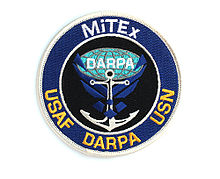This article needs additional citations for verification. (January 2009) |


The Micro-satellite Technology Experiment (MiTEx) is a microsatellite-based mission launched into geosynchronous orbit 21 June 2006 aboard a Delta II rocket. The USAF described the mission as a joint "technology demonstration" mission for the Defense Advanced Research Projects Agency (DARPA), the United States Air Force (USAF) and the United States Navy (US Navy).[1][2]
MiTEx consists of three spacecraft; two inspection satellites, designated USA-187 and USA-188, and an experimental upper stage, designated USA-189.[3] The two inspection satellites were initially used to inspect each other; however, they were later used to inspect DSP-23, a failed missile detection satellite, to find out why it stopped operating.[4]
The MiTEx goal was to demonstrate technologies such as lightweight power and propulsion systems, avionics, structures, commercial off-the-shelf components, advanced communications, and on-orbit software environments.[5]
- ^ "Cape launches Delta II, MiTEx satellite". USAF. 23 June 2006.
 This article incorporates text from this source, which is in the public domain.
This article incorporates text from this source, which is in the public domain.
- ^ Osborn, Michael; Clauss, Craig; Gorin, Barney; Netwall, Chris (18 June 2012). "Micro-Satellite Technology Experiment (MiTEx) Upper Stage Propulsion System Development". AIAA Journal. 43rd AIAA/ASME/SAE/ASEE Joint Propulsion Conference (Rocket-Based Propulsion): 1. doi:10.2514/6.2007-5434. ISBN 978-1-62410-011-6 – via The American Institute of Aeronautics and Astronautics.
- ^ "SPACEWARN Bulletin No. 632". NASA GSFC. 1 July 2006.
 This article incorporates text from this source, which is in the public domain.
This article incorporates text from this source, which is in the public domain.
- ^ Cite error: The named reference
covault-20090114was invoked but never defined (see the help page). - ^ Ray, Justin (22 June 2006). "Experimental Military Microsatellites Reach Orbit". space.com. Retrieved 7 June 2024.